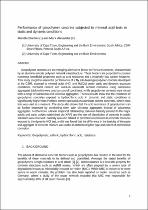 ResearchSpace
ResearchSpace
Performance of geopolymer concrete subjected to mineral acid tests in static and dynamic conditions
JavaScript is disabled for your browser. Some features of this site may not work without it.
- ResearchSpace
- →
- Research Publications/Outputs
- →
- Book Chapters
- →
- View Item
| dc.contributor.author |
Dlamini, Mandla N

|
|
| dc.contributor.author |
Alexander, M

|
|
| dc.contributor.editor | De Jager, Peta | |
| dc.date.accessioned | 2024-04-12T12:35:44Z | |
| dc.date.available | 2024-04-12T12:35:44Z | |
| dc.date.issued | 2024-01 | |
| dc.identifier.citation | Dlamini, M.N. & Alexander, M. 2024. Performance of geopolymer concrete subjected to mineral acid tests in static and dynamic conditions. In <i>Sustainability Handbook: Volume 8</i>. P. De Jager, Ed. S.l.: 52-69. http://hdl.handle.net/10204/13664 . | en_ZA |
| dc.identifier.uri | http://hdl.handle.net/10204/13664 | |
| dc.description.abstract | Geopolymer cements are an emerging alternative binder to Portland cements, characterised by an alumino-silicate polymer network nanostructure. These binders are purported to possess numerous beneficial properties such as acid resistance and a relatively low carbon footprint. This study sought to assess the performance of a fly ash-based geopolymer concrete developed at the CSIR, exposed to mineral acids (HCl and H2SO4) under static and dynamic exposure conditions. Portland cement and calcium aluminate cement concretes using calcareous aggregates (dolomite) were used as control specimens, while geopolymer cements were mixed with a range of calcareous and siliceous aggregates. The test results show that the resistance of geopolymer concretes exposed to hydrochloric acid in dynamic and static conditions is significantly higher than Portland cement and calcium aluminate cement concretes, where mass loss was used as a measure. The study also shows that the acid resistance of geopolymers can be further improved by combining them with siliceous aggregates instead of calcareous aggregates. Furthermore, a linear empirical relationship, between basicity (related to the major acidic and basic oxides established via XRF) and the rate of dissolution of concrete in acidic solutions was observed. Basicity was also related to preferential corrosion in concrete mixtures exposed to the dynamic HCl test, and it was found that the difference in the basicity of the paste and aggregate of concrete mixture was useful in determining the type and extent of preferential corrosion. | en_US |
| dc.format | Fulltext | en_US |
| dc.language.iso | en | en_US |
| dc.publisher | 52-69 | en_US |
| dc.relation.uri | https://sustainability-handbook.alive2green.co.za/magazine/vol8/ | en_US |
| dc.source | Sustainability Handbook: Volume 8 | en_US |
| dc.subject | Geopolymer Cements | en_US |
| dc.title | Performance of geopolymer concrete subjected to mineral acid tests in static and dynamic conditions | en_US |
| dc.type | Book Chapter | en_US |
| dc.description.pages | 52-69 | en_US |
| dc.description.placeofpublication | Cape Town: Alive2Green | en_US |
| dc.description.cluster | Smart Places | en_US |
| dc.description.impactarea | Construction Materials | en_US |
| dc.identifier.apacitation | Dlamini, M. N., & Alexander, M. (2024). Performance of geopolymer concrete subjected to mineral acid tests in static and dynamic conditions. In P. De Jager. (Ed.), <i>Sustainability Handbook: Volume 8</i> 52-69. http://hdl.handle.net/10204/13664 | en_ZA |
| dc.identifier.chicagocitation | Dlamini, Mandla N, and M Alexander. "Performance of geopolymer concrete subjected to mineral acid tests in static and dynamic conditions" In <i>SUSTAINABILITY HANDBOOK: VOLUME 8</i>, edited by Peta De Jager. n.p.: 52-69. 2024. http://hdl.handle.net/10204/13664. | en_ZA |
| dc.identifier.vancouvercitation | Dlamini MN, Alexander M. Performance of geopolymer concrete subjected to mineral acid tests in static and dynamic conditions. In De Jager P, editor.. Sustainability Handbook: Volume 8. [place unknown]: 52-69; 2024. [cited yyyy month dd]. http://hdl.handle.net/10204/13664. | en_ZA |
| dc.identifier.ris | TY - Book Chapter AU - Dlamini, Mandla N AU - Alexander, M AB - Geopolymer cements are an emerging alternative binder to Portland cements, characterised by an alumino-silicate polymer network nanostructure. These binders are purported to possess numerous beneficial properties such as acid resistance and a relatively low carbon footprint. This study sought to assess the performance of a fly ash-based geopolymer concrete developed at the CSIR, exposed to mineral acids (HCl and H2SO4) under static and dynamic exposure conditions. Portland cement and calcium aluminate cement concretes using calcareous aggregates (dolomite) were used as control specimens, while geopolymer cements were mixed with a range of calcareous and siliceous aggregates. The test results show that the resistance of geopolymer concretes exposed to hydrochloric acid in dynamic and static conditions is significantly higher than Portland cement and calcium aluminate cement concretes, where mass loss was used as a measure. The study also shows that the acid resistance of geopolymers can be further improved by combining them with siliceous aggregates instead of calcareous aggregates. Furthermore, a linear empirical relationship, between basicity (related to the major acidic and basic oxides established via XRF) and the rate of dissolution of concrete in acidic solutions was observed. Basicity was also related to preferential corrosion in concrete mixtures exposed to the dynamic HCl test, and it was found that the difference in the basicity of the paste and aggregate of concrete mixture was useful in determining the type and extent of preferential corrosion. DA - 2024-01 DB - ResearchSpace DP - CSIR ED - De Jager, Peta J1 - Sustainability Handbook: Volume 8 KW - Geopolymer Cements LK - https://researchspace.csir.co.za PY - 2024 T1 - Performance of geopolymer concrete subjected to mineral acid tests in static and dynamic conditions TI - Performance of geopolymer concrete subjected to mineral acid tests in static and dynamic conditions UR - http://hdl.handle.net/10204/13664 ER - | en_ZA |
| dc.identifier.worklist | 27695 | en_US |





